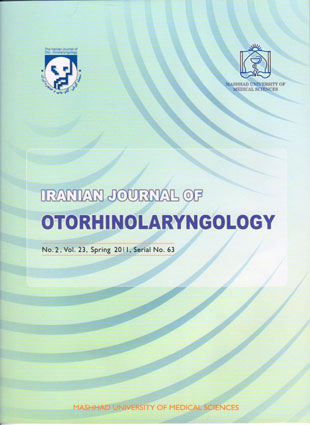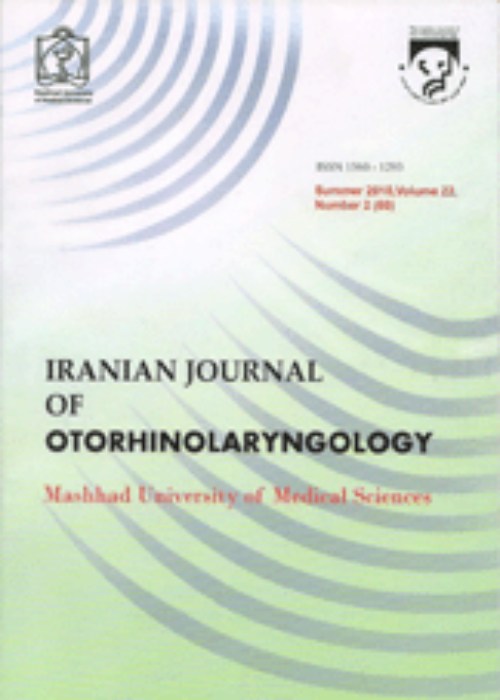فهرست مطالب

Iranian Journal of Otorhinolaryngology
Volume:23 Issue: 2, Mar-Apr 2011
- تاریخ انتشار: 1390/02/28
- تعداد عناوین: 9
-
-
Page 1IntroductionPersistent postinfectious cough (PPC) is a cough that persists longer than 3 weeks or perhaps for many months after a common cold or an upper respiratory tract infection (URTI). PPC has poor response to routine treatment modalities, so it can be a vexing problem for the patient and the physician alike. Our hypothesis was that honey and/or coffee have some beneficial effects in the treatment of PPC. The aim of this study was to evaluate the therapeutic effects of coffee and/or honey in the treatment of patients with PPC.Material And MethodsThis was a double blind randomized clinical trial, conducted on adult patients during a 6-year period from 2003 to 2009. Included in this study were 84 adult participants that had experienced PPC longer than 3 weeks. All of them had the history of several referrals to different physicians and despite treatment, their cough had persisted. Patients with other causes of chronic cough, or systemic disease or with abnormal routine laboratory tests were excluded. All the included 84 participants were distributed into three groups. For all the participants, a jam-like paste was prepared. Each 600 grams of the product consisted of "70 grams original instant coffee" in the first regimen, "500 grams of honey" in the second regimen and "70 grams of instant coffee plus 500 grams of honey" in the third regimen. These participants were told to dissolve 25 grams of the prescribed product in about 200 CC of warm water (under 60o C), and drink this solution every 8 hours for one week. All the participants were evaluated before and at the end of the first week of their treatment, to measure the frequency of their cough. In addition they were under observation for the first month.ResultsComparing the effectiveness of all three treatment regimens, this study found "honey with coffee" as the most effective treatment modality for PPC. (P< 0.001)ConclusionsCombination of honey and coffee can successfully treat the PPC at a short time. Thus, it is recommended for the treatment of PPC.
-
Page 9IntroductionAdenotonsillectomy is one of the most frequent surgical operations on children, which may result in weight gain in a number ways, for instance, by increasing IGF-1 or decreasing respiratory hyperactivity.Materials And MethodsThis was an intervention study with a control group, conducted on fifty 3-10-year-old children who had undergone adenotonsillectomy and on fifty children as the control group. The intervention and control groups were identical in terms of age and sex. Height, weight, mid-arm muscle circumference, waist circumference, and percent body fat measures were performed on the intervention group before and six months after the surgery. The same measurements were also performed on the control group at zero time and six months later. Ultimately, the results were examined and compared.ResultsThe body mass index (BMI) and percent body fat in the intervention group showed a significant change after six months, with P values of 0.002 and 0.024 respectively. There were no significant correlations for other variables.ConclusionBased on the findings of this study, children who had undergone adenotonsillectomy for various indications showed a gradual postoperative increase in their BMI and percent body fat.
-
Page 15IntroductionManagement of pain in children is often inadequate and numerous clinical practice guidelines and policy statements have been published on the subject of pediatric pain. Tonsillectomy is among the most frequent otorhinolaryngologic surgeries, especially in the pediatric age group and after tonsillectomy the patients usually suffer from mild to severe pain for three postoperative days which may limit activity level and intake, leading to dehydration and a prolonged hospital stay. In this study acetaminophen, acetaminophen codeine and ibuprofen have been compared in a single study.Materials And MethodsA randomized, prospective, double-blind study was conducted at the Tabriz pediatric hospital. Patients were selected randomly from the hospitalized patients undergoing tonsillectomy suffering from recurrent tonsillitis or adenotonsillar hypertrophy and assigned to one of three groups (acetaminophen (ACT)-acetaminophen codeine (ACT/C)-ibuprofen (IBU) according to a predetermined randomization code. All the operations were taken place under same conditions by the same surgeon. Objective pain score used for pain assessment and adverse drug reactions were collected on checklists and analyzed using SPSS software.ResultsChi square test results revealed a significant difference between ACT ACT/C IBU groups. Neither acetaminophen nor Ibuprofen at the doses given was able to provide sufficient analgesia. The rate of bleeding in all groups did not show any significant difference according to Pearson-chi-square test (P=0.22). The incidence of anorexia in ACT, ACT/C and IBU groups was 15.7, 7.8 and 25.8 percent, respectively, which showed a significant difference by chi-square test (P=0.045).ConclusionAccording to our study it can be concluded that acetaminophen codeine posses more analgesic effect than acetaminophen and ibuprofen in post tonsillectomy pain management in pediatric patients.
-
Page 21IntroductionEnvironmental fungi, molds and yeasts, can infest the nasal cavity through inhaled air. There is some evidence that they could be the main cause of Chronic Rhino-Sinusitis (CRS) but little is known about the normal fungal flora in the human nose.The objective of this study was to assess the normal fungal flora of the nasal mucus in adults in Kerman.Materials And MethodsWe conducted a cross sectional study. Nasal swabs were used to sample the nasal cavity of 100 adults, 46 men and 54 women between 17 and 60 years old, currently living in Kerman, Iran.ResultsAmong 100 healthy people, one or more types of fungi were detected in 31 (31%) persons; Candida in 12 persons, Aspergillus in 8 persons, Streptomyces in 8 persons, and Penicillium, Nocardia and Mucor in a few persons. In only 4 persons, more than one type of fungi was detected. There was no significant relation between age, sex, education or smoking with the presence of fungi.
-
Page 29IntroductionThe hepatitis B is a viral infection that causes a big problem globally. About 2 billion people worldwide are infected and there are now about 400 million HBV-DNA carriers around the world. HBV infection is the ninth cause of death worldwide and infects about 350 million new cases each year in the world. HBV-DNA can be spotted in different body secretions and fluids, including serum, saliva, tears, urine, amniotic fluid index, and cerumen isolated.Material and MethodsThis is a case - control study on the population of 140 participants (70 patients with chronic hepatitis B as cases and 70 healthy volunteers community as a controls). The presence of HBV-DNA in their serum and ears cerumen using qualitative PCR and quantitative molecular detection Real-Time PCR (BioRad-CFX system) was determined.ResultsCopy of serum HBV were detected in 98.5 % of case group and 7 % of healthy population (control group). In case group, 61 patients (87.2%) had HBV-DNA in their cerumens and 5control subjects(about 7 %) were positive for HBV-DNA in their cerumens. All patients group and two subject (2.8%)of control group, were positive in HBsAg test.Average HB virus genome load in cerumen and serum of chronic HBV patients (group) were 8.98×106 and 3.60×108 copies per ml of the sample respectively.ConclusionLike other body secretions, Ear cerumen is constantly produced and is subject to a pathogen such as HBV infection. The possiblity of disease transmission seems unlikely through Cerumen, however considering the average copy of HBV genome in the cerumen, no doubt, it can be claimed that there is a potential transmission risk of HBV infection.
-
Page 37IntroductionAlthough the incidence and prevalence of chronic suppurative otitis media (CSOM) has been decreased in recent decades, but it is still a major health problem in both developing and developed countries. CSOM can cause major and life-threatening complications such as hearing loss, meningitis and cerebral abscess. Since hearing loss is the most common complication of CSOM, we aimed to evaluate audiometric profile in patients with CSOM and its relation with intra-operative pathologic findingsMaterials And MethodsBetween 2008-2010, 80 patients with CSOM subjected to tympanomastoidectomy or tympanoplasty entered this study.The detailed patients’ history, physical examination, audiometric evaluations and findings during surgeries were collected. Finally, the associations between data were analyzed.ResultsCSOM had higher prevalence among female (67.5%), but difference was not statically significant. Speech recognition test and air-bone gap were significantly associated with CSOM (P<0.001). While cholesteatoma and granulation significantly associated with air-bone gap (P=0.044) and speech recognition test (P=0.032), respectively, ossicular defects significantly associative with both of them (P=0.001 and P=0.032, respectively). There was not any association between sclerosis and audiometric parameters. Also presence of the cholesteatoma and ossicular defects associated with size of the tympanic perforation (P=0.001).ConclusionThe preoperative and surgical findings can predict the patients’ conductive hearing loss in chronic otitis media, but this relationship is not significant in all variables.
-
Page 43IntroductionMyxofibrosarcoma was originally described as the myxoid variant of Malignant Fibrous Histiocytoma (MFH), a high-grade and aggressive sarcoma, which is very uncommon in the head and neck region, with about 100 cases reported up to now. MFH occurring in the maxillary sinus is so rare that only 23 cases have been reported. We hereby report a case of myxofibrosarcoma in the maxillary sinus. Case Report:The case was a 54-year-old male with symptoms of toothache in the right posterior maxillary teeth, a swelling adjacent to maxillary molar region and symptoms of chronic maxillary sinusitis. In clinical examination, the teeth were sensitive to percussion and palpation, but no caries and restoration was detected on his molar teeth. He was suffering from local pain and tenderness over his midface and mild fever, fatigue and some nonspecific vague pain. CT scan showed a mass lesion involving right nasal cavity, maxillary and ethmoidal sinuses. A low-grade malignancy arising from the right maxillary sinus was highly suspected. A surgery was done to remove the mass. The histological and immunohistochemical studies proved the diagnosis of myxoid variant of Malignant Fibrous Histiocytoma. Therefore radiotherapy and chemotherapy was started for the patient but six months later the symptoms returned and CT scan showed a right maxillary and ethmoidal mass that extended to base of the skull. Maxillectomy and ethmoidectomy were performed for the patient, but 2 months later he died because of the extension of the tumor, which confirmed the necessity of early diagnosis.
-
Page 49Actinomycosis is a systemic chronic bacterial infection caused byActinomyces israelii, an anaerobic organism normally resident in the human mouth. However, the actinomycosis of the larynx is very rare, and only about 15 cases have been reported in the literature so far. Most of the cases reported occurred in patients who had previously undergone radiotherapy for laryngeal cancer. Here we report a case of actinomycosis of the larynx in a 14-year-old shepherd boy who was not immunocompromised but had a history of tooth extraction two months prior to admission to the hospital and severe laryngitis one year prior to admission. In conclusion, laryngeal actinomycosis might be related to poor oral hygiene and mucosal barrier disruption, as well as to being immunocompromised.
-
A Penetrating Pellet Jeopardizing Internal Carofid ArteryPage 53


